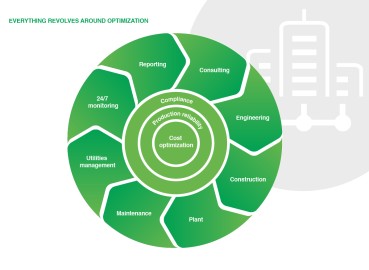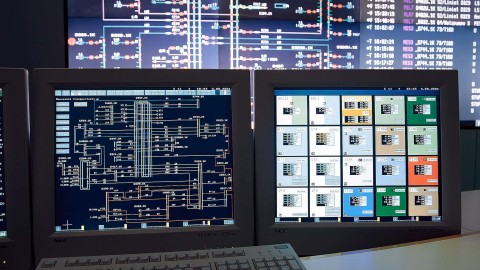Energy management in building automation in the remote work era
The coronavirus pandemic is largely over, but many companies have seen office occupancy numbers drop and are keeping fewer buildings open. This trend could accelerate as more people work from home. This presents both challenges and opportunities for building automation.
Facility energy management in particular harbors tremendous potential for savings. Rooms that are not being used fully or at all do not have to be lit or heated for 100% occupancy.
We provide the following services:
- Monitoring and analyzing the energy and maintenance needs of your building automation systems
- Planning cost-cutting optimization measures such as adjusting the lighting
- Reducing the power consumed by ventilation and heating
- Handling all aspects of facility operation, including extensive reporting
- Identifying leaks
We aim to achieve the same goal for all our customers: a smart building. That requires a carefully designed energy management plan and intelligent control systems. But what steps are needed in order to maximize the impact of your optimization initiative? How can it be quantified?
This article focuses exclusively on optimizing your building. The steps in the optimization process are illustrated using real-life examples so that you can set the right building automation goals for your needs.
How to make your building smart
The first step in sustainably optimizing building energy management is to clearly structure your goals.
Possible building automation goals:
- Save energy / improve energy efficiency
- Optimize heating and lighting
- Improve occupant comfort
- Reduce your building’s environmental footprint
- Comply with fire protection requirements or health and safety rules such as automatically locking doors
If your goal is to save energy and thus operate more cost-effectively, you should turn to a highly experienced partner to implement your building automation solution.
This is illustrated by simple real-life examples:
Sides of buildings can exhibit large temperature differences in the spring and fall. The southern façade often heats up significantly while the northern side largely remains in the shade. However, the outside temperature is virtually identical. If external sensors then measure the building façade temperatures, their readings will be distorted and the rooms will continue to heat up, even on the sunny side.
Truly smart solutions prevent this problem. To learn more, read our blog post: Smart solutions, not panaceas!
The design concept – an all-in-one solution for your building
The quality of the design concept often determines whether building automation can be successfully implemented and controlled.
3 steps to an all-in-one solution:
- Thoroughly analyze the baseline situation to identify critical points in the system.
- A solution is supposed to provide answers to problems. Much depends on finding the right product. A manufacturer-independent consultation is the only way to identify the best possible solution.
- The final phase: implementation, operation, further expansion and constant support.
This blog post contains more information on design concepts.
System integration: the first step in the optimization process
Before integrating any building automation, you should be thoroughly briefed on the available brands along with available technical and business options. You can only be energy-efficient or make products reliably if your building automation is running smoothly.
The main factor to consider when choosing a brand: Products have to be intelligently combined and thus offer the best possible value.
Extensive knowledge is needed to provide effective manufacturer-independent advice, assessments and solutions. Experience can help minimize errors and lower product costs. For example, sensitive areas such as laboratories require redundant high-quality solutions. However, low-cost products are often perfectly fine for heating control purposes.
This graphic illustrates the optimization process:
How building automation makes energy management smart
Information generated by connected systems can be harnessed to lower energy and maintenance costs. Mobile measurement kits can identify opportunities to improve energy efficiency. It is much like a CAT scan at the hospital. Your building is assessed from head to toe for causes such as old blowers and motors. The main symptom: high energy consumption. By conducting analyses, you first learn how your building really functions before alleviating its symptoms.
Building automation and energy management have a symbiotic relationship. What do we mean by that? Well, the heating system has to invest a lot of extra energy in order to reach a certain temperature. That is often unavoidable. However, you can free up that energy for heating by eliminating waste in other areas. That is why waste analyses are so important for successful energy management.
After attaining this goal, current energy consumption has to be constantly visualized. Technicians should set upper and lower limits and incorporate alarm monitoring for certain functions. Constant monitoring, fault reporting and effective alarm management keep your building smart.
Factsheet: “Fast track to a smart building”
See our free whitepaper, “Fast track to a smart building”, to learn how to implement truly smart solutions and understand the importance of the four-phase process.
If you have technical difficulties sending the form, please contact us by e-mail at [email protected] .






